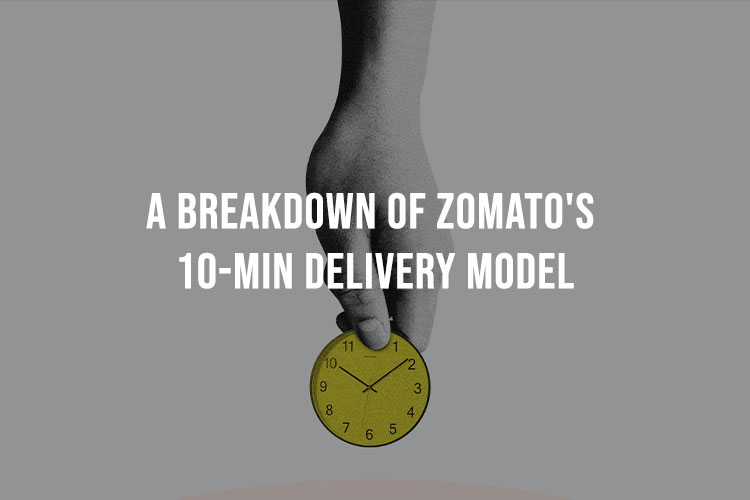What is the first thing you think of when hunger strikes? Ordering a wholesome meal from your favourite restaurant, right?
There is no denying that food delivery apps have taken centre stage in all our lives, and there is no going back now as ordering in has become the new normal.
Zomato, the now 5.4 billion dollar business, was founded in 2008, and began as a simple platform to give recommendations to customers looking to dine out. In a nutshell, the strategy of Zomato was to lay out concrete information and menus of restaurants and provide a basic rating of these restaurants to their customers. However, they’ve been evolving constantly. With time, the company evolved into delivering food orders that were placed by their clients on Zomato’s platform. Zomato also partnered with restaurants in different cities to boost sales and engage new customers. Customised services like Zomato Gold made customers feel unique and important.
Duopolies in the food delivery industry.
Swiggy and Zomato’s duopoly in the Indian food delivery market is a testament to the effectiveness of their digital marketing strategies. These two food delivery platforms have become the go-to choice for people looking for convenient and hassle-free meal options. The competition between Swiggy and Zomato is fierce, with each brand vying for a larger market share through various strategies, including discount coupons, offers, packaging quality, delivery time, and advertising. Zomato digital marketing strategy has been particularly effective, with the brand utilizing social media and search engines to reach its target audience. Zomato’s SEO strategy is designed to ensure that the brand ranks high on search engine result pages, making it more visible to potential customers. Additionally, Zomato’s social media presence is strong, with the brand using platforms like Facebook, Twitter, and Instagram to engage with customers and promote its services. Swiggy, on the other hand, has focused on a hyperlocal strategy, targeting specific areas and neighborhoods to increase its customer base. Despite the competition, both Swiggy and Zomato continue to dominate the food delivery industry in India, with impressive subscriber numbers and constant valuation growth. Overall, the success of Swiggy and Zomato can be attributed in large part to their effective digital marketing strategies.
Zomato’s new 10-min delivery model: Explained
Beating the competition may be challenging, but Zomato has proved that you can stand out from the rest with the right marketing strategies. Have you ever heard of ‘Foodiebay’? Think twice, because this used to be Zomato’s name. The company has shown immense growth; from providing menus and restaurant locations to customers looking to dine out, to its evolution to a food delivery app and the recent Zomato ‘10-min’ delivery scheme.
Zomato intends to execute its 10 min delivery plan by building a ‘Cloud or Dark Store’ in areas of high demand. Before we understand what a dark store is and how it works. Let us discuss the reason behind initiating the 10-min delivery plan.

Building your business success with our strategies and solutions.
Increase your Sales: Lets boost your sales with irrestible marketing tactics
Control your expenses: Take charge of your expenses and optimize your performance.
Build your team: Partner with us to build a high-performing team for your business
Quick commerce played an important role
The assumed notion of quick commerce was actually only built relatively recently, when the pandemic forced everyone to sit at home and take advantage of online businesses and deliveries. During this period, waiting for orders for two days or weeks was unacceptable, and customers demanded fast deliveries.
The increased demand for fast-paced deliveries forced e-commerce sites like Amazon and Grofers to provide instant deliveries. If you are on a shopping spree and are located in a metro city, you would know that ordering electronic items, mobile phones, and laptops is very convenient. Your order is usually delivered by the next morning, or sometimes even on the same day. Initially, food delivery would also take approximately an hour or 30 minutes. However, changing scenarios and rising competition led Zomato to follow the concept of quick commerce, and launch their fast 10-min delivery service.
Why launch a 10-minute food delivery plan?
A primary reason behind the immense success of Domino’s was their 30-minute guaranteed delivery. Domino’s has been following this strategy for almost 10 to 15 years, so why can’t other brands do the same? The strategy makers behind the scenes at Zomato, understood that the time slot of 30-minute fast delivery would soon become obsolete.
This idea of fast delivery can potentially boost demand and revenue exponentially, and give them a one-up on the competition. Zomato business model recognizes the importance of quick commerce and took the initiative to come up with the plan to launch the 10-min delivery scheme, to meet increasing demand and gain customers who were not ready to wait any longer. By incorporating fast-paced delivery as a key component of their business model, Zomato has set itself apart from its competitors and gained a loyal customer base.
With the success of their quick commerce approach, Zomato’s business model has become a benchmark for other players in the food delivery industry to follow. By constantly innovating and improving their services, Zomato has established itself as a leader in the fast-paced world of quick commerce.
How do ultra-fast delivery apps work?
After Covid, many online delivery apps started ultra-fast delivery for their customers. Ultra-fast grocery delivery apps like Zepto, Instamart and Blinkit were already delivering food items and essentials within short time periods. But, what makes Zomato different is that they deliver hot and freshly cooked food to your doorstep in just 10 minutes. Zomato narrowed down the strategy of ultra-fast delivery and partnered with Blinkit, earlier known as Grofers, to make the 10-minute delivery possible.
Ultra-fast delivery apps work by establishing a storehouse or warehouse in an area with high demand. They collect the essentials as soon as the order is placed and make fast deliveries to your doorstep.
How have dark stores and AI changed the game?
Zomato marketing strategy has been designed to ensure that it remains a leading player in the food delivery market. With its ultra-fast delivery service that promises freshly cooked hot food in just 10 minutes, Zomato has set itself apart from other food delivery apps.
To make this possible, Zomato has established well-built warehouses called Dark stores or Cloud Kitchens in metro cities. Zomato marketing strategy relies on leveraging the power of artificial intelligence and customer data to analyse geographical areas with the highest demand, as well as the most popular cuisines or food items in those areas. This allows them to keep things prepped and ready to go, ensuring that the food is freshly-prepared and delivered to the customer by the nearest rider available. Overall, Zomato marketing strategy has been successful in making it a top player in the market, with its ultra-fast delivery service being a key differentiator

Pros and cons of the new 10-min model
Though the idea of 10-min food delivery is exciting, it is receiving a fair amount of backlash from some netizens. We are well aware of the benefits of fast food delivery, such as saved time, hot and fresh food, enhanced customer service, better opportunities for restaurants, and more job opportunities across the board. However, the concerns raised about this fast delivery service must not be overlooked either.
Uncertainty about the quality of food
When it comes to Zomato marketing strategy, one of the key aspects that they have focused on is assuring customers of freshly cooked food prepared in a hygienic environment. However, some people might argue that with the pressure of delivering food within just ten minutes, there is a higher chance of receiving improperly cooked food or raw meat. Despite this, Zomato marketing strategy is designed to minimize the risk of such incidents occurring. They have established well-equipped kitchens or Dark stores where the food is freshly prepared, ensuring that the food is cooked to perfection. Additionally, the use of artificial intelligence and customer data allows Zomato to predict demand and prepare food in advance, reducing the chances of any rush or delay. Furthermore, Zomato has a strict quality control process in place that ensures that every meal is checked for hygiene and quality before it is delivered. Overall, while there might be concerns around the speed of delivery, Zomato marketing strategy is aimed at minimizing any potential risks and ensuring that customers receive high-quality food every time.
Peak hours could hinder the fast delivery
Promising a delivery at peak hours can be tricky, as peak hours are more prone to traffic jams, and restaurants receive even more crowds during those hours. To enable this, Zomato intends to rely on their dark rooms or cloud kitchens. Though it might sound like they’ve got everything under control, peak times and rush hours are bound to result in traffic jams and other uncertainties, affecting the 10 min delivery plan’s success.
The burden on an already overworked delivery person network
We are all human beings, and overexertion is not healthy for anyone. This could be the case for the Zomato delivery executive network as they zip around trying to fulfil Zomato’s 10 min delivery promise. The increased chances of road accidents, cases of rash driving, and traffic light violations will likely affect several riders’ careers and lives. Also, delivering food later than the promised time slot could result in bad customer reviews, affecting the incentives and salaries of the employees.
It is important to note, that Zomato has specified that their 10-min delivery model will not rely on the driving speed and capability of their delivery executives, but how it actually ends up playing out remains to be seen.
Climatic issues
10-min delivery is not an easy task with changing weather conditions in India. Heavy rains, chilly winters, and scorching heat could damage the food and impact the rider’s health.
The future of the delivery industry
With further development of AI in every aspect of human life, food delivery services are likely to harvest its potential to incorporate a business model that seemed impossible some years ago. They can generate information and analyse the population in a certain area to distinguish their needs like, what they like, where they live, what is the prime time for a person to order a meal, etc. Almost anything is possible because of the advances in AI technology.



